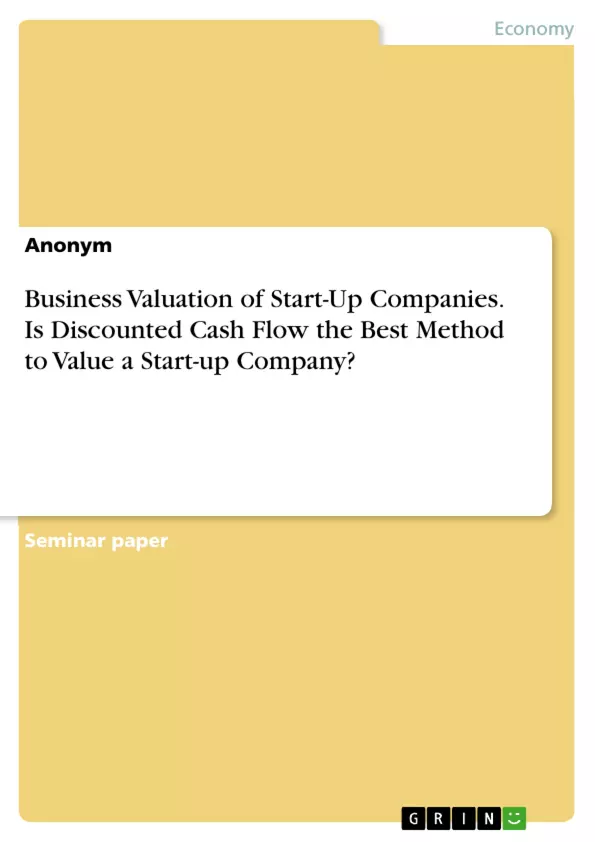The purpose of this term paper is to study the different methods and criteria of the Business valuation of companies and comparing them and check their applicability to Start-Ups. The difference between the valuation of normal and new companies should be also illustrated. This will be approached with the help of specialist literature, journals and magazines. The practical part will be illustrated by the practical process of choosing the best possible business valuation method of an early fintech Start-Up in Germany.
It is important when someone wants to buy something that he knows its value and that he is sure that he has not paid more than its real value. It is relatively easy to know the value of the things we buy in a daily basis by comparing the price to other things or when comparing the current price to the price in the past.
However, the situation is quite different when we buy a company with all its departments and knowledge. Here we will have to use some specialized methods to be able to know the value closest to reality and to avoid significant material losses when an evaluation error occurs.
Business Valuation is one of the most difficult challenges in business. The reason is that we live nowadays in an extremely changing world. That makes it difficult to measure the valuation of a company and expect their development for the next years. It is also much more difficult and trickier to value a Start-Up company due to the lack of important information about new companies such as corporate governance mechanisms. Therefore, the valuation process of Start-Up Companies looks a little bit different from the valuation of normal companies.
Inhaltsverzeichnis (Table of Contents)
- Introduction to the subject
- The purpose of the term paper:
- The key question is:
- Theoretic basics of business valuation and start-ups
- Basics of Business Valuation
- Dimensions of Business Valuation
- Approaches of The Business Valuation
- Basics of Start-Ups
- Definition of a Start-Up
- Development Phases of a Start-Up
- Business Valuation of Start-Ups
- Importance of Start-Ups Business Valuation
- Criteria of Start-Ups Business Valuation
- Business Valuation Methods
- The Market Multiple Method
- Venture Capital Method
- The Development Stage
- Discounted Cash Flow
- Choosing the Business Valuation Method for LANO
- Conclusion
Zielsetzung und Themenschwerpunkte (Objectives and Key Themes)
This term paper aims to explore the methods and criteria used in business valuation, comparing their applicability to start-ups. It aims to illustrate the differences between the valuation of established companies and new companies. The paper utilizes specialist literature, journals, and magazines, and a practical example will be provided by analyzing the best possible business valuation method for an early fintech start-up in Germany.
- Methods and criteria used in business valuation.
- Applicability of valuation methods to start-ups.
- Differences between the valuation of established and new companies.
- Practical application of valuation methods to an early fintech start-up in Germany.
- The relevance of Discounted Cash Flow as a valuation method for start-ups.
Zusammenfassung der Kapitel (Chapter Summaries)
- Introduction to the subject: This chapter introduces the importance of understanding the value of a company before acquiring it. It emphasizes the difficulty of valuing a company due to the dynamic nature of the business environment, particularly for start-ups. The chapter highlights the purpose of the term paper and the key question it aims to answer.
- Theoretic basics of business valuation and start-ups: This chapter explores the fundamental concepts of business valuation, including dimensions and approaches. It then delves into the characteristics of start-ups, defining them, outlining their development phases, and emphasizing the importance and criteria of their valuation.
- Business Valuation Methods: This chapter presents various methods employed in business valuation, including the Market Multiple Method, the Venture Capital Method, the Development Stage, and Discounted Cash Flow.
- Choosing the Business Valuation Method for LANO: This chapter analyzes the chosen start-up company and discusses the criteria used for selecting the most appropriate valuation method.
Schlüsselwörter (Keywords)
The main keywords and focus topics of this work include business valuation, start-ups, Discounted Cash Flow, Market Multiple Method, Venture Capital Method, Development Stage, fintech, and early-stage companies. The paper focuses on the challenges and methods of valuing new ventures, particularly those operating in the rapidly evolving fintech sector.
- Citar trabajo
- Anonym (Autor), 2019, Business Valuation of Start-Up Companies. Is Discounted Cash Flow the Best Method to Value a Start-up Company?, Múnich, GRIN Verlag, https://www.grin.com/document/519909



